Digitising Recordings
Michael Quinn looks at a recent CMC project which has resulted in a collection of historical recordings of Irish composers' works being restored and transferred to CD.
A treasure trove can only claim to be such if the jewels contained within it are allowed to sparkle and shine. Which is precisely the dilemma that had faced the Contemporary Music Centre’s collection as it built and added to its historically rich, musically varied sound archive.
Containing more than 6000 performances on every format from the earliest recording technologies to the most recent, CMC’s sound archive contains an invaluable record of the past six decades of Irish music life. It’s a brutal fact of life, however, that many of the earliest recordings -- those on shellac, vinyl and, especially, on the profusion of tape formats that dominated both professional and domestic recording techniques for half a century from the 1930s onwards -- are in increasing danger of succumbing to their own de-magnetised
death.
A selection of reels which were transferred.
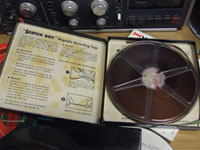
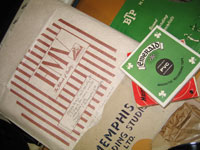
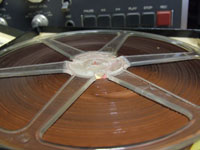
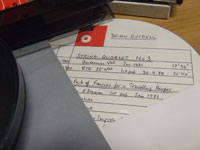
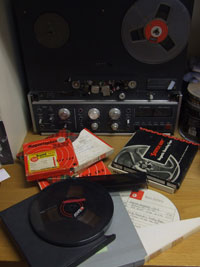
For all its democratic ubiquity and all-encompassing utility, tape has proved to be one of the most vulnerable of recording formats, one compromised by the very fact of being played, threatened by potentially damaging storage conditions and prone, through the mere passage of time, to partial or total degradation in quality.
All of which (coupled with the increasing scarcity of suitable and reliable playback machines) made it frustratingly difficult for CMC to make tape-recorded performances from its archive available for public use at the Centre’s listening stations, or even to copy the same for scholars and performers throughout Ireland and, indeed, across the world.
In March 2007, with project funding from the Heritage Council, CMC embarked upon an ambitious programme to rescue its collection of recordings on tape from the format’s various vulnerabilities by transferring them into a much more durable and dependable format. In the past year an intensive operation to transfer fragile tape recordings into a digital database has been labouring away behind the scenes.
A decision was made to focus on tape recordings made before 1982 and to prioritise those items that were unique in that they had no corresponding duplicate version in any other, more recent format.
114 reels were assessed by CMC’s audio-visual assistant Niamh Heery, who discovered that 65 had no traceable duplicate on another format, 47 had possible duplicates, and audio copies in CMC’s own library already existed for 32 of the recordings. Which is where Niamh’s work really began in earnest.
Using rigorous guidelines laid down by UNESCO’s Records and Archives Management Programme, Niamh encountered more than the anticipated degradation of tapes through age.
‘I discovered there were so many problems that could befall reel-to-reel tapes,’ she says. ‘If they’re stacked the wrong way -- neverhorizontally! -- stored near a radiator or in sunlight or in a damp room they’re usually in trouble. Some even had mould growing on them and I had to isolate these so they didn’t contaminate the other tapes.’
The very fact that some tapes had been previously played caused problems, too, especially if they had been listened to on a number of machines during the course of their life. (Although falling outside the parameters of the project’s initial phase, a similar process was also conducted with a number of tape cassettes in the CMC archive with Niamh’s initial selection giving preference to those recordings that had been identified as being in high demand by users of the Centre’s library.) All the tapes were transferred in ‘real time’, but if that process was laborious, it also proved to be enormously beneficial.
‘You could have a tape that would take an hour to transfer and then another hour or more to fix in the new format, and to break it into suitable tracks for easier access for users,’ explains Niamh. ‘But there were other tapes, quarter-inch reels especially, where you had to make a decision about how complicated (and, therefore, how lengthy) the transfer was going to be and whether it would produce the kind of end product you were after.’
Having made a provisional catalogue of the 65 unique recordings, Niamh then undertook a more thorough analysis of each item. Although reels were labelled, details of dates, performers, duration and other key information was often missing or, if present, had to be forensically checked. A crucial assessment of the recording’s quality and the likely success of an attempt to transfer it to digital format was also made at this stage.
In the event, fewer than half were assessed to be viable for transfer, with just 30 reels from CMC's collection found to be unique and historically important and as such a priority for digitisation. From those, a number of full works have subsequently been transferred to CD and have found their way into CMC’s publicly accessible library, among them, adds Niamh, ‘several little gems’.
Prominent among those are a number of recordings dating from the 1950s-’70s originally donated by the estate of James Wilson to Trinity College Dublin and loaned to CMC for digital transfer -- including Ditto’s Daughter in a 1977 performance from the Royal Theatre Group, Copenhagen in Danish and his 1965 choral work Tom O’Bedlam. Already the restorations have played a crucial part in illustrating and illuminating a key period in the late composer’s creative life for one scholar currently working on a biography of the composer.
Wilson’s collection also contained valuable private recordings he had made of works by Charles Villiers Stanford, Brian Boydell and Aloys Fleischmann.
All too rare recordings of music by Ina Boyle were another find. Donated by Trinity College, Dublin, they included a 1948 performance of Wildgeese that pre-dates RTÉ’s recording of the work (also in the CMC sound archive) by seven years.
In all, more than half (57%) of CMC’s collection of quarter-inch reel recordings was evaluated during the year-long project. In addition, 66 cassettes from the sound archive’s vast collection were identified as being sole existing recordings, and almost a third of those (20) were also transferred to digital format.
Stored now in CMC’s humidity-controlled basement, these historic recordings have been given a new lease of life, one that makes them easily and safely available to the Centre’s multifarious users at home and abroad.
2008 will see the beginning of the second, no less crucial, phase of CMC’s efforts to restore and make available its unique archive of recordings. With a further grant from the Heritage Council, work is already underway to consolidate and build upon the achievements of the first phase.
While concerns remain about the continuing durability of tapes that weren’t assessed over the past year and as new recordings on both quarter-inch reels and cassettes are donated to the archive from other sources, CMC is now looking to extend the achievements of the initial project to rescue historically and artistically significant recordings and to make them available in a digital format.
As the digital archive begins to grow in volume and import, it also raises for serious (and tantalising) consideration the specific shape and structure, point and purpose of the other, and no less voluminous, items in the archive -- manuscript scores, privately and commercially published scores and concert programmes not least. How these disparate but interlinked elements can best be collated into a coherent resource alongside the audio recordings is the challenge that awaits the Contemporary Music Centre and its many users in the future. For now, however, the vital search-and-rescue work of transferring ailing analogue recordings to digital formats continues apace.
Michael Quinn is a music journalist. He lives in Co. Down, Northern Ireland.
The views expressed in this interview are those of the persons concerned and are not necessarily those of the Contemporary Music Centre.
More recordings from the project -
James Wilson; Ditto Daughter
James Wilson; Tom O'Bedlam
Ina Boyle; Wildgeese
